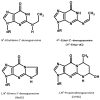Alcohol-Derived Acetaldehyde Exposure in the Oral Cavity
- PMID: 29342885
- PMCID: PMC5789370
- DOI: 10.3390/cancers10010020
Alcohol-Derived Acetaldehyde Exposure in the Oral Cavity
Erratum in
-
Correction: Alessia Stornetta et al. Alcohol-Derived Acetaldehyde Exposure in the Oral Cavity. Cancers 2018, 10, 20.Cancers (Basel). 2018 Mar 16;10(3):74. doi: 10.3390/cancers10030074. Cancers (Basel). 2018. PMID: 29547517 Free PMC article.
Abstract
Alcohol is classified by the International Agency for Research on Cancer (IARC) as a human carcinogen and its consumption has been associated to an increased risk of liver, breast, colorectum, and upper aerodigestive tract (UADT) cancers. Its mechanisms of carcinogenicity remain unclear and various hypotheses have been formulated depending on the target organ considered. In the case of UADT cancers, alcohol's major metabolite acetaldehyde seems to play a crucial role. Acetaldehyde reacts with DNA inducing modifications, which, if not repaired, can result in mutations and lead to cancer development. Despite alcohol being mainly metabolized in the liver, several studies performed in humans found higher levels of acetaldehyde in saliva compared to those found in blood immediately after alcohol consumption. These results suggest that alcohol-derived acetaldehyde exposure may occur in the oral cavity independently from liver metabolism. This hypothesis is supported by our recent results showing the presence of acetaldehyde-related DNA modifications in oral cells of monkeys and humans exposed to alcohol, overall suggesting that the alcohol metabolism in the oral cavity is an independent cancer risk factor. This review article will focus on illustrating the factors modulating alcohol-derived acetaldehyde exposure and effects in the oral cavity.
Keywords: ALDH2; DNA adduct; acetaldehyde; alcohol; cancer; ethanol; exposure; microbiome; oral cavity.
Conflict of interest statement
The authors declare no conflict of interest.
Figures
Similar articles
-
Increased levels of the acetaldehyde-derived DNA adduct N 2-ethyldeoxyguanosine in oral mucosa DNA from Rhesus monkeys exposed to alcohol.Mutagenesis. 2016 Sep;31(5):553-8. doi: 10.1093/mutage/gew016. Epub 2016 Apr 7. Mutagenesis. 2016. PMID: 27056945 Free PMC article.
-
Formation of acetaldehyde-derived DNA adducts due to alcohol exposure.Chem Biol Interact. 2010 Dec 5;188(3):367-75. doi: 10.1016/j.cbi.2010.08.005. Epub 2010 Sep 21. Chem Biol Interact. 2010. PMID: 20813101 Review.
-
Alcohol and aldehyde dehydrogenase polymorphisms and a new strategy for prevention and screening for cancer in the upper aerodigestive tract in East Asians.Keio J Med. 2010;59(4):115-30. doi: 10.2302/kjm.59.115. Keio J Med. 2010. PMID: 21187698 Review.
-
Implications of acetaldehyde-derived DNA adducts for understanding alcohol-related carcinogenesis.Adv Exp Med Biol. 2015;815:71-88. doi: 10.1007/978-3-319-09614-8_5. Adv Exp Med Biol. 2015. PMID: 25427902 Review.
-
Salivary acetaldehyde concentration according to alcoholic beverage consumed and aldehyde dehydrogenase-2 genotype.Alcohol Clin Exp Res. 2008 Sep;32(9):1607-14. doi: 10.1111/j.1530-0277.2008.00739.x. Epub 2008 Jul 8. Alcohol Clin Exp Res. 2008. PMID: 18616675 Clinical Trial.
Cited by
-
TM4SF19 controls GABP-dependent YAP transcription in head and neck cancer under oxidative stress conditions.Proc Natl Acad Sci U S A. 2024 Feb 13;121(7):e2314346121. doi: 10.1073/pnas.2314346121. Epub 2024 Feb 5. Proc Natl Acad Sci U S A. 2024. PMID: 38315837 Free PMC article.
-
Characterization of oral microbiota and acetaldehyde production.J Oral Microbiol. 2018 Jul 6;10(1):1492316. doi: 10.1080/20002297.2018.1492316. eCollection 2018. J Oral Microbiol. 2018. PMID: 30013723 Free PMC article.
-
Relationship between acetaldehyde concentration in mouth air and characteristics of microbiota of tongue dorsum in Japanese healthy adults: a cross-sectional study.J Appl Oral Sci. 2019 Jun 13;27:e20180635. doi: 10.1590/1678-7757-2018-0635. J Appl Oral Sci. 2019. PMID: 31215600 Free PMC article.
-
Analysis of Novel DNA Adducts Derived from Acetaldehyde.Biomolecules. 2025 Jun 16;15(6):878. doi: 10.3390/biom15060878. Biomolecules. 2025. PMID: 40563518 Free PMC article.
-
The Interaction between CLSPN Gene Polymorphisms and Alcohol Consumption Contributes to Oral Cancer Progression.Int J Mol Sci. 2024 Jan 16;25(2):1098. doi: 10.3390/ijms25021098. Int J Mol Sci. 2024. PMID: 38256171 Free PMC article.
References
-
- Homann N., Tillonen J., Meurman J.H., Rintamaki H., Lindqvist C., Rautio M., Jousimies-Somer H., Salaspuro M. Increased salivary acetaldehyde levels in heavy drinkers and smokers: A microbiological approach to oral cavity cancer. Carcinogenesis. 2000;21:663–668. doi: 10.1093/carcin/21.4.663. - DOI - PubMed
-
- Anantharaman D., Marron M., Lagiou P., Samoli E., Ahrens W., Pohlabeln H., Slamova A., Schejbalova M., Merletti F., Richiardi L., et al. Population attributable risk of tobacco and alcohol for upper aerodigestive tract cancer. Oral Oncol. 2011;47:725–731. doi: 10.1016/j.oraloncology.2011.05.004. - DOI - PubMed
Publication types
LinkOut - more resources
Full Text Sources
Other Literature Sources
Molecular Biology Databases
Miscellaneous



